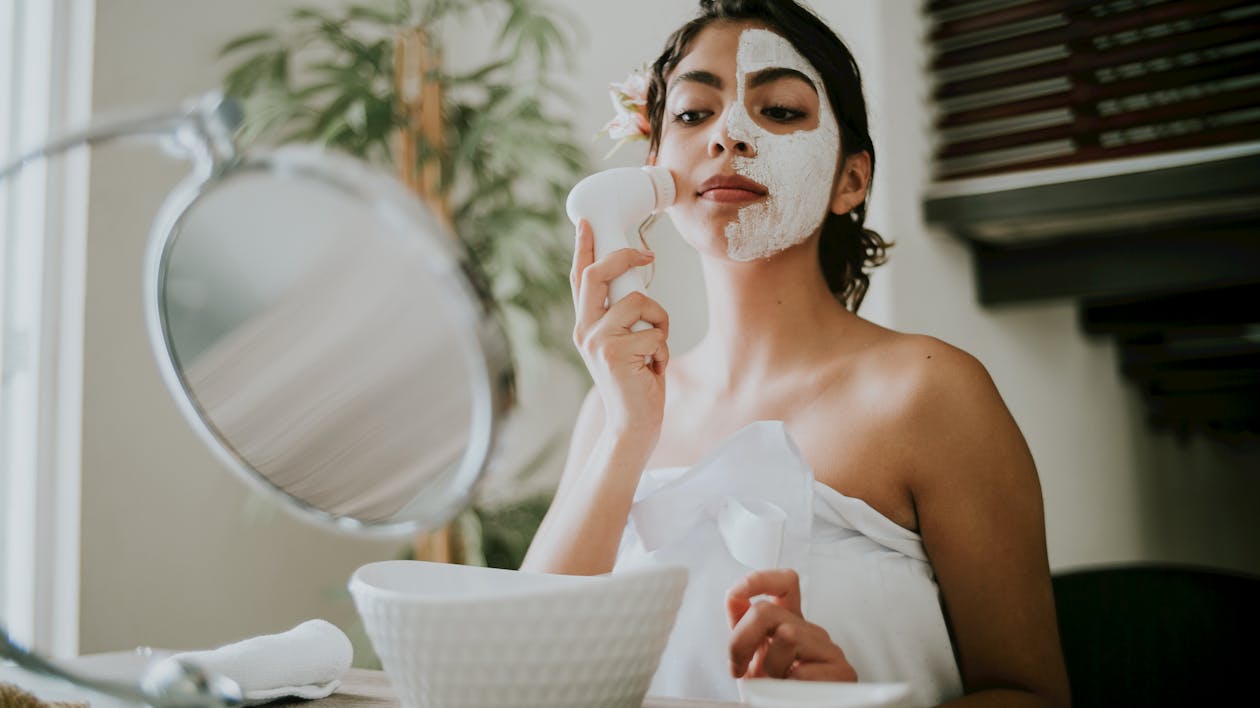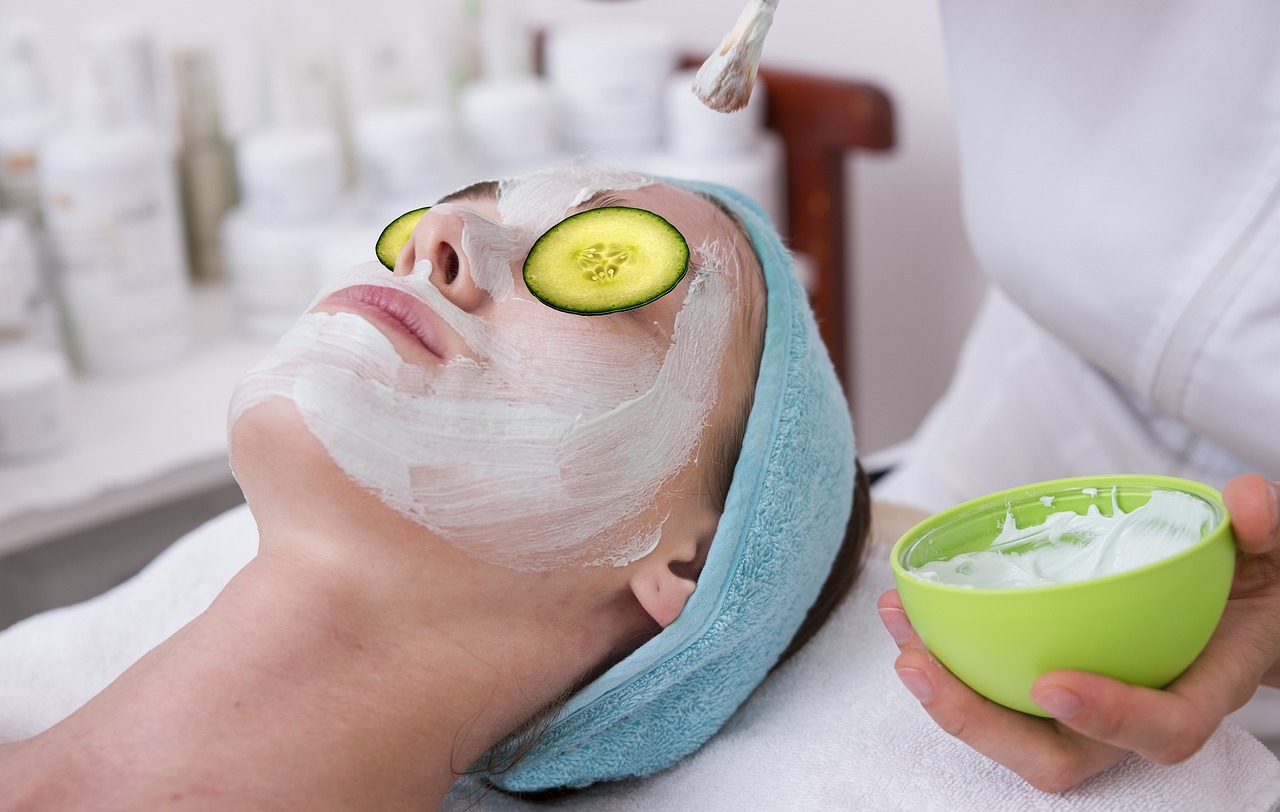BLOG

Effective Skincare for Oily Skin
Managing oily skin can be challenging with constant shine, breakouts, and makeup struggles. But achieving a balanced, glowing complexion is possible. Hello and welcome to "Expert Tips: How to Treat Oily Skin with an Effective Routine."
In this guide, we offer professional strategies to manage oily skin effectively. From understanding the root causes of excess oil production to selecting the right products and crafting a daily regimen, we provide the insights you need to take control of your skin’s health.
Let’s dive in and uncover the secrets to a shine-free, radiant complexion!
Understanding Oily Skin: Causes and Characteristics

Image by Silviarita via Pixabay
Managing oily skin effectively begins with understanding its root causes and distinct characteristics. Here’s what you need to know:
Excess Sebum Production
Oily skin is primarily caused by the overproduction of sebum, a natural oil produced by the sebaceous glands. Sebum is essential for maintaining skin health by providing moisture and protection, but an excess leads to a shiny complexion and clogged pores, often resulting in acne. Recognizing signs of excess sebum production helps in choosing products and routines that regulate oiliness without stripping necessary oils.
Genetic Factors
Skin type is largely determined by genetics. IYou have a higher chance of having oily skin if it runs in your family. While you can’t change your genetic predisposition, you can manage it effectively. This understanding helps set realistic expectations and encourages a personalized approach to skincare, focusing on routines tailored to your skin’s specific needs.
Hormonal Changes
Oil production might be increased by hormonal changes that occur during puberty, menstruation, pregnancy, or menopause. For example, during puberty, the surge in androgens can cause sebaceous glands to produce more oil. Similarly, hormonal changes during the menstrual cycle or pregnancy can lead to unexpected oiliness. Being aware of these influences allows you to adjust your skincare regimen accordingly, incorporating oil-control products or treatments during these periods.
Environmental Influences
Environmental factors also affect oil production. High humidity levels, common in tropical or coastal areas, can stimulate sebaceous glands to produce more oil. Pollution can exacerbate the problem by clogging pores and leading to breakouts. Diet can also impact skin; high consumption of dairy or sugary foods may contribute to oiliness. Identifying these external factors enables proactive steps, like using a mattifying primer in humid weather or incorporating antioxidants into your routine to combat pollution.
Understanding these causes and characteristics is crucial for building an effective skincare routine that manages oiliness and promotes overall skin health.
Choosing the Right Cleanser for Oily Skin

Image by Amar Preciado via Pexels
Selecting the right cleanser is crucial for managing oily skin. It’s about removing excess oil and impurities while maintaining skin health. Here’s how to choose the best cleanser for oily skin:
Ingredients to Look For
Key ingredients can help control oil production and prevent breakouts:
Salicylic Acid: A BHA that breaks down oil and exfoliates dead skin cells, preventing clogged pores and acne.
Benzoyl Peroxide: Known for its antibacterial qualities, this substance lowers inflammation and targets germs that cause acne.
Tea Tree Oil: A natural ingredient with antimicrobial and anti-inflammatory benefits, it reduces sebum production and soothes irritated skin.
Avoid Harsh Cleansers
Avoid cleansers with harsh chemicals or high alcohol content, as they can strip natural oils and lead to increased oil production. Opt for gentle formulas that maintain your skin’s natural balance.
Foaming vs. Gel Cleansers
Foaming Cleansers: Provide a satisfying lather and effectively remove dirt and oil but can be too drying.
Gel Cleansers: Lightweight and less likely to strip essential oils, penetrate pores deeply without clogging them, making them a better option for oily skin.
Frequency of Cleansing
Cleanse your face twice a day—morning and night. This helps remove accumulated oil and impurities. Avoid over-cleansing, which can irritate your skin and lead to increased oil production.
By focusing on the right ingredients and gentle formulas, you can effectively manage oily skin and maintain a clear, healthy complexion.
The Importance of Toning and How to Do It Right

Toning is often overlooked in skincare routines, but it’s crucial, especially for oily skin. Here’s why toning is essential and how to do it correctly:
Balancing pH Levels
Toning helps restore the skin's natural pH balance, often disrupted by cleansing. For oily skin, a balanced pH level reduces overactive sebaceous glands, leading to less oil production and fewer breakouts. Think of toner as a reset button, bringing your skin back to its optimal state.
Removing Residual Impurities
Cleansing alone can leave behind traces of makeup, dirt, and oil. Toners efficiently eliminate these lingering pollutants, guaranteeing a purified complexion. This step is vital for oily skin to prevent clogged pores and acne, giving you the cleanest canvas possible.
Minimizing Pores
Large pores are common for oily skin, but toners with astringent properties can help tighten and minimize their appearance. Smaller pores reduce the chance of oil and dirt settling in, leading to fewer clogs and breakouts over time. This makes the texture of the skin smoother and more polished.
Prepping for Moisturizers and Serums
Toning also prepares your skin to absorb subsequent skincare products more effectively. After toning, your skin is primed for serums and moisturizers, allowing these products to penetrate deeper and work better. Think of it as laying the groundwork for the rest of your skincare routine, enhancing the efficacy of all your favorite products.
Incorporating a toner into your skincare routine can significantly benefit oily skin, balancing pH levels, removing impurities, minimizing pores, and prepping your skin for other products.
How to Tone Correctly
Now that you understand why toning is essential, let's talk about how to do it right. Here are some expert tips:
1. Choose the Right Toner: Look for alcohol-free toners with ingredients like salicylic acid, witch hazel, or tea tree oil, which are particularly beneficial for oily skin.
2. Apply with Care: Use a cotton pad to gently swipe the toner across your face, focusing on areas that are prone to oiliness and breakouts. Take care not to irritate your skin.
3. Follow with Hydration: Always follow your toner with a hydrating serum and a lightweight, non-comedogenic moisturizer to lock in moisture without adding excess oil.
Making toning a consistent part of your skincare routine can help balance your skin, clear out impurities, minimize pores, and set the stage for more effective skincare results. Here's to a shine-free, healthier complexion!
Hydration: Why Even Oily Skin Needs Moisturizer

A prevalent misperception is that moisturizer is unnecessary for oily skin. However, incorporating a lightweight, non-comedogenic moisturizer is essential for managing oily skin. Here’s why:
Balance Oil Production
Skipping moisturizer can make your skin oilier. When skin feels dry, it produces more sebum, leading to a greasy shine. Using a lightweight moisturizer helps regulate sebum production, preventing your skin from overcompensating with excess oil.
Prevent Dehydration
Oily skin can still become dehydrated, lacking water but not oil. Dehydration prompts your skin to produce more oil, worsening the issue. Proper hydration maintains a healthy moisture balance, keeping your skin hydrated without becoming overly oily.
Improve Skin Barrier
A well-moisturized skin barrier protects against environmental pollutants and irritants, which can exacerbate oiliness and cause breakouts. A good moisturizer strengthens this barrier, making your skin more resilient.
Enhance Treatment Efficacy
Hydrated skin absorbs and responds to other skincare treatments more effectively. Whether using salicylic acid for acne or retinoids for texture, hydration ensures these products work better and are less likely to cause irritation.
In short, don’t skip moisturizer because you have oily skin. The right kind of hydration balances oil production, prevents dehydration, strengthens your skin barrier, and enhances the efficacy of other treatments.
Exfoliation: How Often and What Products to Use

Image by ArtPhoto_studio via Freepik
Exfoliation is essential for oily skin, helping to remove dead skin cells and unclog pores, reducing breakouts and blackheads. However, it’s important to exfoliate correctly. Here’s a quick guide:
Frequency of Exfoliation
Less is more. Overexfoliating can strip natural oils, leading to more oil production. Exfoliate 2-3 times a week to maintain a balanced skincare routine without damaging your skin.
Choosing the Right Exfoliants
For oily skin, chemical exfoliants like salicylic acid (a BHA) and glycolic acid (an AHA) are ideal. Salicylic acid penetrates pores to dissolve excess oil and reduce inflammation, while glycolic acid gently exfoliates dead skin cells on the surface, improving texture and tone.
Gentle Physical Exfoliants
Occasional use of gentle physical exfoliants, such as those with fine particles like jojoba beads or rice powder, can be beneficial. Use them sparingly—about once a week—to avoid irritation and microtears.
Post-Exfoliation Care
After exfoliating, follow up with a hydrating toner and a light, oil-free moisturizer to replenish moisture and prevent overproduction of oil.
By incorporating these tips, you can effectively manage oily skin and enjoy a clearer, more balanced complexion.
Sun Protection: Finding the Right SPF for Oily Skin

Image by EugenePetrunin via Freepik
Finding the right sunscreen for oily skin can be challenging, but sun protection is essential for preventing premature aging, sunburn, and skin cancer. Here are expert tips to help you choose the right SPF for oily skin:
Opt for Oil-Free Formulas
Choose sunscreens labeled as oil-free or non-comedogenic to avoid clogging pores. Brands like Neutrogena, La Roche-Posay, and EltaMD offer excellent options for oily skin.
Choose a Matte Finish
To control shine, opt for sunscreens with a matte finish. Ingredients like silica and dimethicone help absorb excess oil, keeping your skin fresh and shine-free.
Consider Mineral Sunscreens
Mineral sunscreens with zinc oxide or titanium dioxide provide broad-spectrum protection and are less irritating. They sit on top of the skin and reflect UV rays, making them ideal for oily and acne-prone skin.
Incorporate SPF into Your Makeup Routine
Use makeup products with built-in SPF, like foundations, primers, and powders designed for oily skin. Brands like IT Cosmetics, BareMinerals, and Fenty Beauty offer options that combine sun protection with oil control.
By following these tips, you can find a sunscreen that protects your skin from UV rays while keeping oily skin in check. Enjoy the sun responsibly and let your skin glow in all the right ways!
Nighttime Routine: Key Steps for Overnight Care

Image by Sora Shimazaki via Pexels
A thoughtful nighttime routine can help manage oily skin, keeping excess oil and breakouts at bay. Here’s a concise guide to treat your oily skin effectively before bed:
1. Double Cleansing
Step 1: Use an oil-based cleanser to dissolve makeup, sunscreen, and daily grime. Oil cleansers remove excess sebum without stripping natural moisture.
Step 2: Follow with a gentle water-based cleanser to wash away remaining impurities. Choose one formulated for oily skin to maintain balance.
2. Use a Balancing Toner
Apply a toner with witch hazel or salicylic acid to tighten pores and reduce shine. These ingredients exfoliate and clarify the skin, removing excess oil and preventing clogged pores.
Apply with a cotton pad or pat onto your face with your hands, allowing it to absorb fully.
3. Apply a Lightweight Serum
Choose serums with niacinamide to regulate oil production and reduce inflammation. Hyaluronic acid is also beneficial, providing hydration without clogging pores.
This combination keeps your skin hydrated and balanced without a greasy feel.
4. Non-Comedogenic Moisturizer
Use a gel-based or water-based non-comedogenic moisturizer to avoid clogging pores. These formulations offer hydration without adding extra oil, ensuring your skin remains fresh and matte.
By consistently following these steps—double cleansing, using a balancing toner, applying a lightweight serum, and finishing with a non-comedogenic moisturizer—you can wake up to a clearer, more balanced complexion. Make these steps a nightly habit for healthier, well-managed skin.
Diet and Lifestyle Tips to Manage Oily Skin
It takes more than just skincare products to manage oily skin. Here are expert-backed tips on how diet and lifestyle choices can help keep unwanted shine at bay:
Incorporate a Balanced Diet
Rich in Nutrients: Consume a diet high in fruits, vegetables, whole grains, and lean meats.
Antioxidants & Omega-3s: Foods like berries, spinach, and salmon reduce inflammation and improve skin health.
Stay Hydrated
Water Intake: Drink at least eight glasses of water daily to flush out toxins and keep skin hydrated.
Hydrating Foods: Include cucumbers and watermelon in your diet for extra hydration.
Limit Sugary and Processed Foods
Reduce Sugar: High sugar intake can increase oil production. Choose natural sweeteners such as fruit or honey.
Avoid Processed Foods: Cut down on fast food and processed snacks to control excess oil.
Incorporate Regular Exercise
Boost Circulation: Exercise improves blood circulation, nourishing skin cells.
Unclog Pores: Sweating helps unclog pores. Ensure you cleanse your skin properly after workouts to avoid breakouts.
By consistently following these diet and lifestyle tips, you'll achieve a balanced, oil-free complexion. The advantages will make the work worthwhile!
Common Mistakes to Avoid When Treating Oily Skin
Treating oily skin effectively means avoiding common pitfalls that can worsen the issue. Here’s what to watch out for:
Over-Washing Your Face
Mistake: Washing too often to control oil.
Solution: Cleanse twice daily with a gentle, non-stripping cleanser. Over-washing can lead to increased oil production as your skin tries to compensate.
Skipping Moisturizer
Mistake: Avoiding moisturizer, fearing it will increase oiliness.
Solution: Use a lightweight, oil-free moisturizer to keep your skin hydrated and balanced. This helps regulate oil production rather than increase it.
Using Harsh Products
Mistake: Applying products with high alcohol content or strong astringents.
Solution: Choose gentle, noncomedogenic products with ingredients like salicylic acid or niacinamide. These help manage oil without irritating your skin.
Neglecting Sun Protection
Mistake: Avoiding sunscreen because of fears of added shine.
Solution: Opt for non-greasy, oil-free sunscreens. Proper sun protection is essential to prevent skin damage and excess oil production.
Avoiding these mistakes will help you maintain a balanced, healthy complexion. The goal is to manage oil effectively, not eliminate it entirely.
Simple Homecare Regimen for Oily Skin
This routine helps manage oil production, keep pores clear, and maintain hydration without clogging pores.
Morning Routine:
Cleanse:
PCA Skin Facial Wash Oily/Problem: Removes excess oil and impurities without over-drying.
Correct:
PCA Skin Acne Gel: Contains salicylic acid to exfoliate and clear pores.
Hydrate:
PCA Skin Clearskin: Lightweight moisturizer that hydrates and soothes while controlling oil.
Protect:
PCA Skin Weightless Protection SPF 45: Offers broad-spectrum protection with a non-greasy formula.
Evening Routine:
Cleanse:
PCA Skin Facial Wash Oily/Problem: Removes impurities and excess oil from the day.
Correct:
PCA Skin Intensive Clarity Treatment 0.5% Pure Retinol Night: Reduces acne and signs of aging with retinol.
Hydrate:
PCA Skin Clearskin: Apply the same lightweight moisturizer from the morning.
Weekly Treatments:
Exfoliate:
PCA Skin Pore Refining Treatment (1-2x per week): Exfoliates and clears pores.
Mask:
PCA Skin Detoxifying Mask (1x per week): Clay and charcoal mask to absorb excess oil and refine skin.
Additional Tips:
Consistency: Follow the routine consistently for best results.
Patch Test: Test new products to ensure they don’t irritate.
Blotting Paper: Use during the day to manage excess oil.
Hydration: Maintain hydration with a moisturizer to balance oil production.
For a personalized plan, call Cara Mia Medical Spa at (860) 370-5978 or schedule a consultation with Margarita.

Managing oily skin effectively involves a combination of the right products, consistent routines, and patience.
By choosing oil-free moisturizers, incorporating gentle exfoliation, and consistently using sunscreen, you can transform your skin from shiny and troubled to balanced and radiant.
Remember, every skin type is unique, so don’t hesitate to experiment to find what works best for you. With dedication and the right approach, achieving a healthy, glowing complexion is entirely possible. Embrace your skincare journey with confidence and watch your skin thank you for the care and attention it receives!
Start Here
Copyright © SkillyLily 2023. All right reserved


